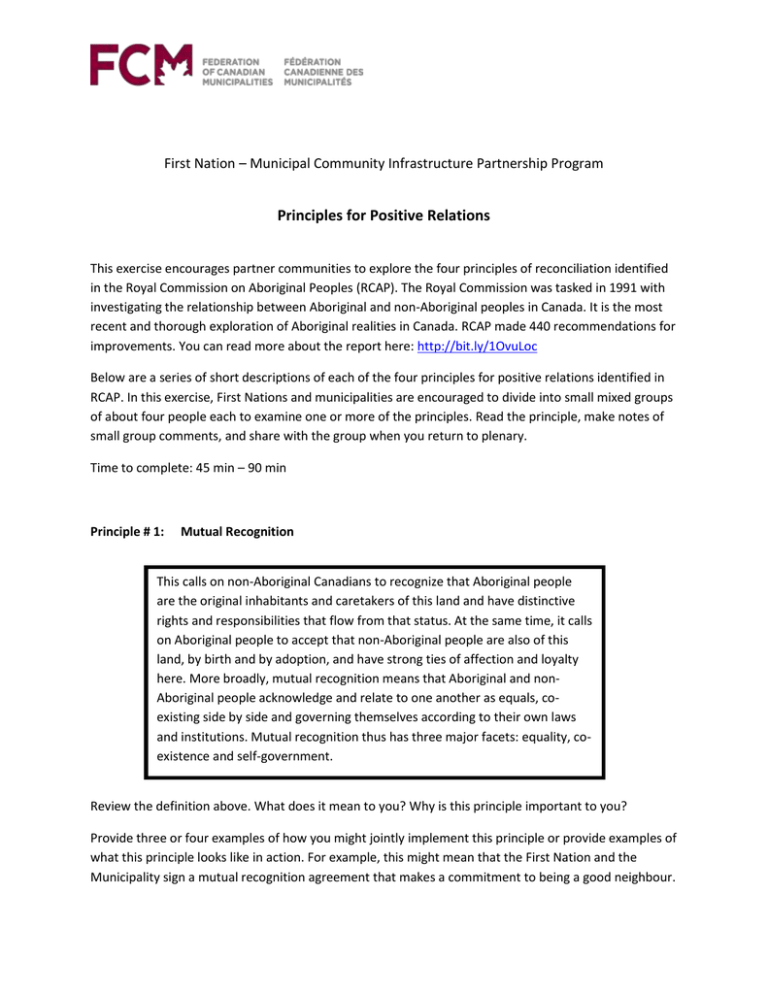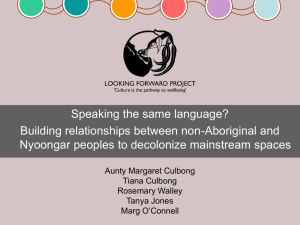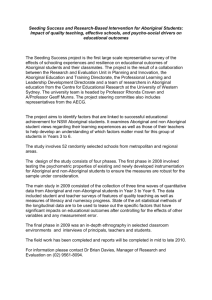Principles for Positive Relations
advertisement

First Nation – Municipal Community Infrastructure Partnership Program Principles for Positive Relations This exercise encourages partner communities to explore the four principles of reconciliation identified in the Royal Commission on Aboriginal Peoples (RCAP). The Royal Commission was tasked in 1991 with investigating the relationship between Aboriginal and non-Aboriginal peoples in Canada. It is the most recent and thorough exploration of Aboriginal realities in Canada. RCAP made 440 recommendations for improvements. You can read more about the report here: http://bit.ly/1OvuLoc Below are a series of short descriptions of each of the four principles for positive relations identified in RCAP. In this exercise, First Nations and municipalities are encouraged to divide into small mixed groups of about four people each to examine one or more of the principles. Read the principle, make notes of small group comments, and share with the group when you return to plenary. Time to complete: 45 min – 90 min Principle # 1: Mutual Recognition This calls on non-Aboriginal Canadians to recognize that Aboriginal people are the original inhabitants and caretakers of this land and have distinctive rights and responsibilities that flow from that status. At the same time, it calls on Aboriginal people to accept that non-Aboriginal people are also of this land, by birth and by adoption, and have strong ties of affection and loyalty here. More broadly, mutual recognition means that Aboriginal and nonAboriginal people acknowledge and relate to one another as equals, coexisting side by side and governing themselves according to their own laws and institutions. Mutual recognition thus has three major facets: equality, coexistence and self-government. Review the definition above. What does it mean to you? Why is this principle important to you? Provide three or four examples of how you might jointly implement this principle or provide examples of what this principle looks like in action. For example, this might mean that the First Nation and the Municipality sign a mutual recognition agreement that makes a commitment to being a good neighbour. Principle # 2: Mutual Responsibilities Ideally, Aboriginal peoples and Canada constitute a partnership in which the partners have a duty to act responsibly both toward one another and also toward the land they share. The principle of mutual responsibility, then, has two facets….[First] Since each partner has the capacity to act in a way that affects the prosperity of the overall enterprise, each partner is also liable to suffer from the mistakes or wrongdoing of the other partners. This mutual vulnerability on the part of the partners gives rise to mutual obligations. By virtue of this relationship, each partner has an obligation to act with the utmost good faith with respect to the other partners on matters covered by their joint endeavour. …[Second]Aboriginal peoples and Canadian governments both have an obligation to act with the utmost good faith toward each other with respect to the lands in question. Review the definition above. What does it mean to you? Why is this principle important to you? Provide three or four examples of how you might jointly implement this principle or provide examples of what this principle looks like in action. For example, this might mean that the First Nation and the Municipality agree to inform each other of development plans they are considering. Principle # 3: Mutual Respect From mutual recognition flows mutual respect… the quality of courtesy, consideration and esteem extended to people whose languages, cultures and ways differ from our own but who are valued fellow-members of the larger communities to which we all belong. In this sense, respect is the essential precondition of healthy and durable relations between Aboriginal and nonAboriginal people in this country. Review the definition above. What does it mean to you? Why is this principle important to you? Provide three or four examples of how you might jointly implement this principle or provide examples of what this principle looks like in action. For example, this might mean that the First Nation and Municipality agree to host one joint social event for their communities each year to help overcome racism. Principle #4: Sharing & Cooperation Partners must recognize each other's basic rights, including, in this instance, rights of selfgovernment and rights of equality as peoples. They must also display respect for their respective cultures and institutions…Our histories, public institutions and popular cultures must give greater recognition to what is often unacknowledged: the relation of sharing that is at the foundation of the Canadian federation and its economy. Both parties need to be in a position to engage in exchanges on an equal basis. Meaningful sharing is not possible under conditions of poverty and dependence... …Sharing must take a form that enhances, rather than diminishes, people's capacity to contribute to the whole. Review the definition above. What does it mean to you? Why is this principle important to you? Provide three or four examples of how you might jointly implement this principle or provide examples of what this principle looks like in action. For example, this might mean that the First Nation and the Municipality agree to come to each other’s aid in times of environmental disaster without expectation of compensation







